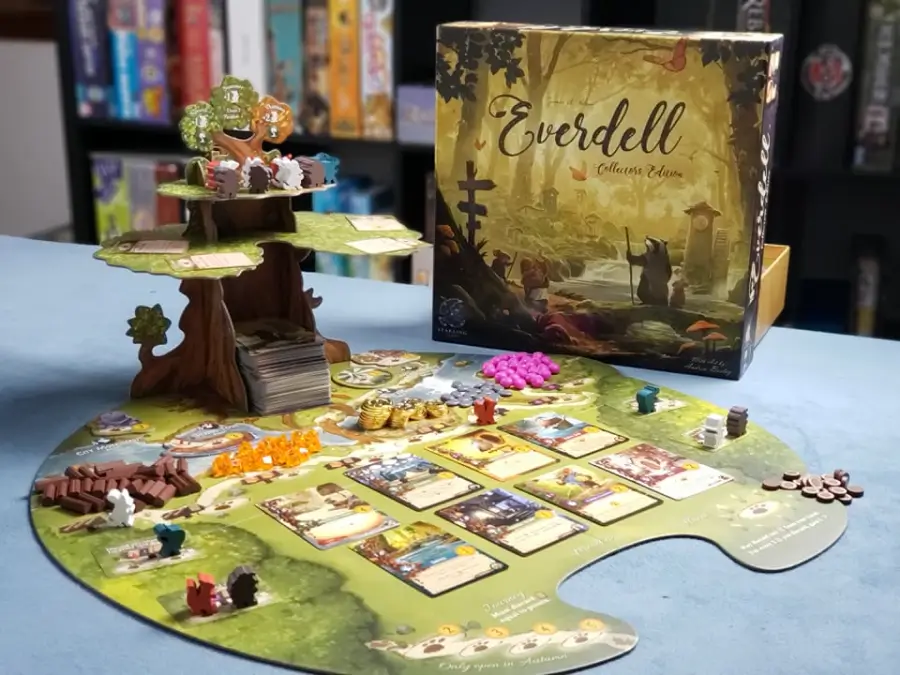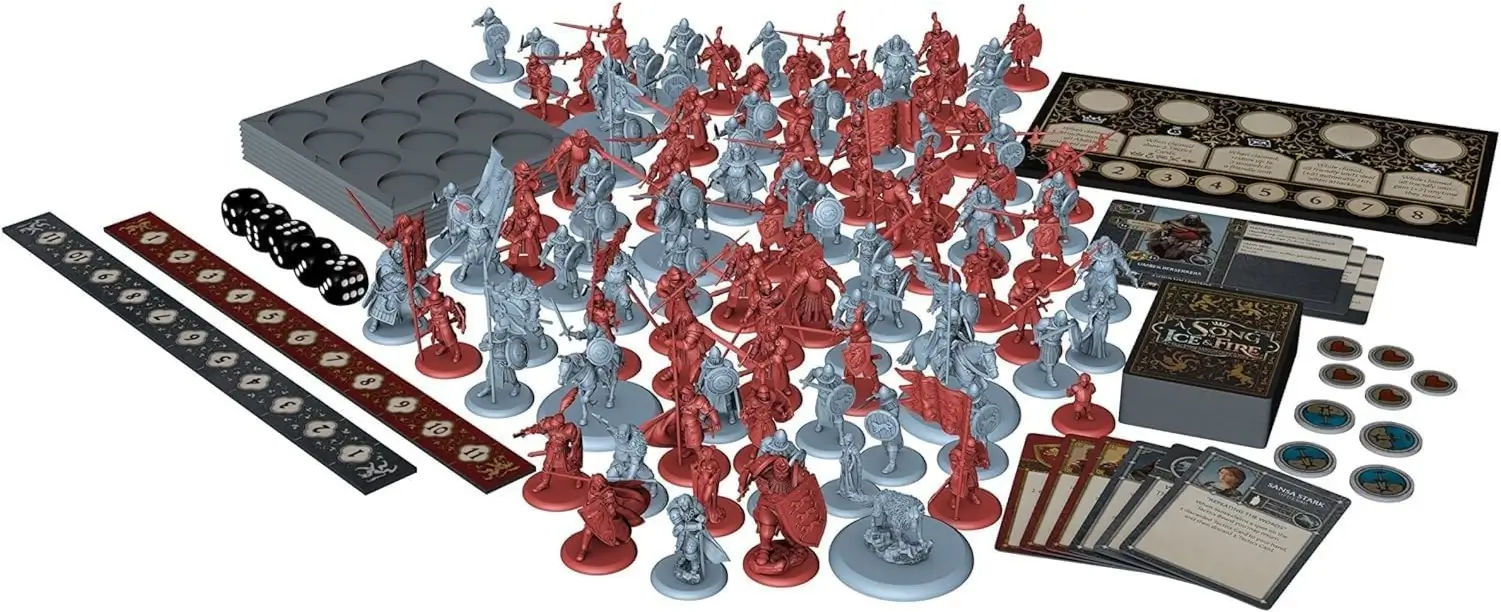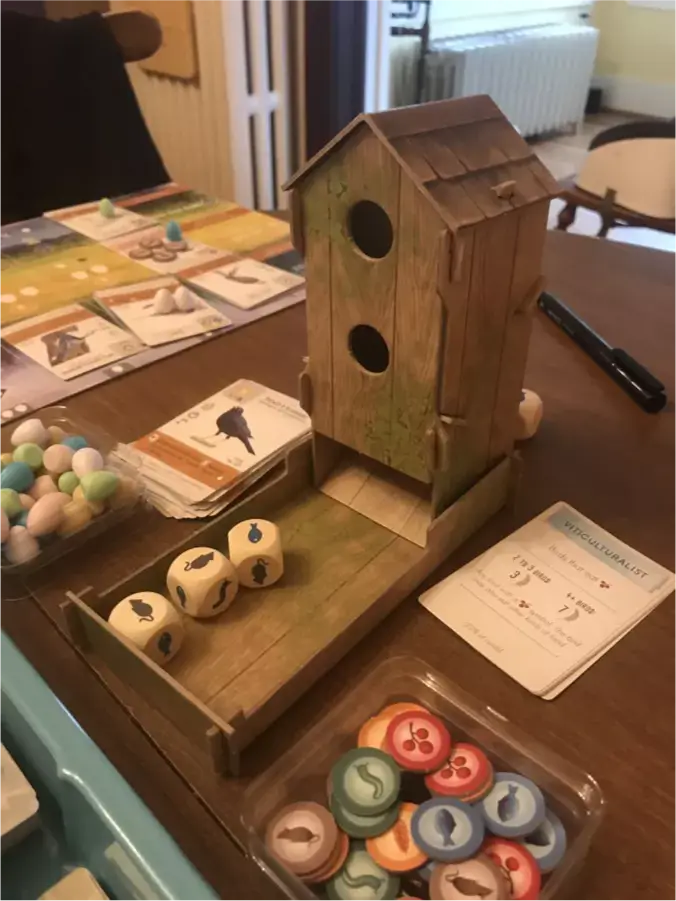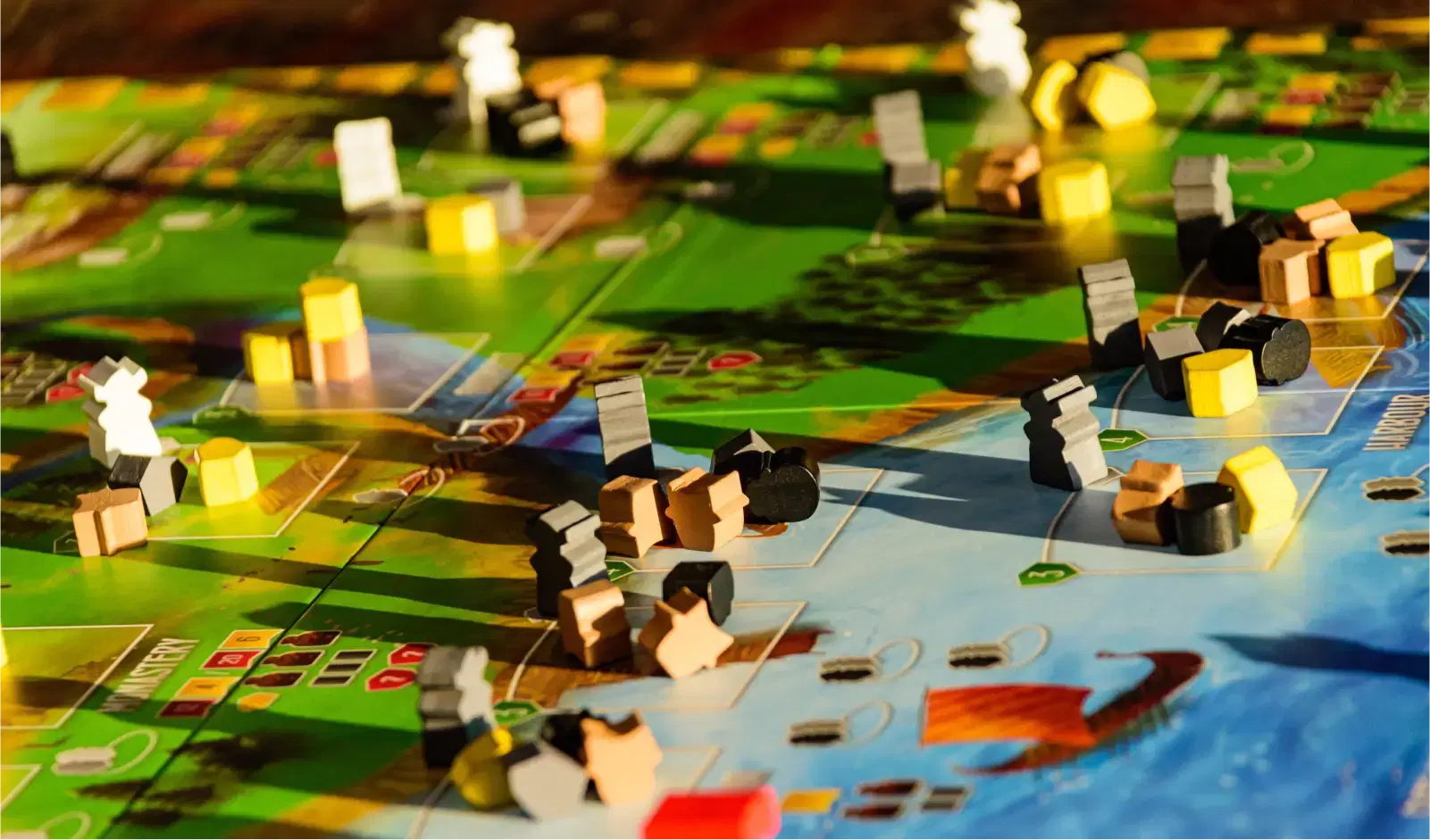Tips & tricks
Boost your game's table presence
Raiders of the North Sea (2015)
The tree in Everdell. The extensive naturalist artwork in Wingspan. The skulls and gears in Tzolk'in. The strikingly clean design of Tokaido. Those shiny little resource cubes in Terraforming Mars.
Table presence can be hard to define, but people know it when they see it. It doesn't always require vast size, or expensive materials, or ultra-customised minis, though all those things can help. Often what it needs is just one strong idea: pure and original, applied 'across the board'. (Sorry.)

That tree in Everdell (Photo:
Maybe you're working on the Big One - the dream game; the one that got you into this wild hobby in the first place. The one you know is going to get your name out there. Maybe you're creating a super limited edition gift, or work of art. Maybe you're prepared to spare no expense. Or maybe you're looking for just one affordable way to add a bit of sparkle to an otherwise sensible, straightforward game.
Whatever the reason may be, you want your boardgame to stand out. You want some of that sweet, sweet table presence.
You've come to the right place.
Small design tweaks for big visual impact
Some of these ideas can be implemented in-house by Launch Tabletop; others can't at present, but we'll work with you to incorporate materials and components from external providers.
Many of these suggestions include examples of real-world games that have implemented them, but we encourage you to put your own spin on the basic concept.
Size does matter
We're going to put the bleeding obvious one up front and get it over with. Yes, making your game enormous can and will turn heads. In fact, if a game takes up the entire table, it has massive table presence by default - in the most literal sense.
But that's all this is: a literal interpretation. Peruse any forum discussion on table presence and you'll see that quite a few otherwise unremarkable games definitely stick in peoples' memories due to their sheer bulk. But you'll also see several trim and compact games that make these lists over and over, without relying on behemoth size.
So if you have a big complex concept, and you're confident it will sell at a higher price point, lean into it. Lavish artwork on every component. Throw in that flavour text. Luxuriate in a two-digit font size. More cards! Bigger minis! No drinks on the table! Make your players do pilates to reach the draw pile!
It's time to do some gamespreading.
Games that take up the whole table
7 Wonders, Firefly: The Game, Twilight Imperium, Scythe, Terraforming Mars

No room for drinks or snacks on the table when Scythe is underway (photo: Tim Chuon)
A token gesture
Now let's take a look on the opposite end of the size scale.
Minis are the final form in the 'token > pawn > meeple > mini' evolutionary cycle. These small three-dimensional semi-realistic models of characters, machines, and objects can be cast or 3D-printed, plastic or metal, plain or painted, but no matter how they're made or prepped, they're - let's be honest - kind of cute and awesome.
Unlike tokens, pawns and meeples, which stand-in for the player, minis are detailed enough to function as fully-fledged characters in their own right, or to represent established characters in licensed games. They're a quality upgrade to tokens, and they can lend your game a lot of presence, creating a whole tiny universe on the table.
Due to multiple Kickstarter campaigns packing boardgames with minis to justify a higher price point, some people view minis as an unnecessary embellishment designed to take your money. Counterpoint: how is any part of the boardgame hobby necessary? Whimsy and fun and 'play for the sake of play' is the point. And if you're here reading this article, chances are, you like your toys on the shiny side.
Games with minis that grab your attention
Betrayal at House on the Hill, Star Wars: Armada, Cthulu: Death May Die, A Song of Ice & Fire

The starter set for A Song of Ice and Fire.
Ooo, shiny!
Apparently humans love shiny things because we evolved to seek out the glimmer of fresh water. We may have water on tap now, but shiny things still catch our eye - and you can use this to draw people to your boardgame.
Here, you've got two major approaches: add shine through your choice of materials, or through printed finishes.
When it comes to materials, metal components can be pricey, but their luxury value is undeniable. Metal tokens, minis and coins all offer a level of detail and weight that will make your game a pleasure to touch and play. Glass tokens provide many of the same benefits, plus fun colour options, and may be cheaper. However, glass components are less common, less versatile, and more fragile. An alternative to this is transparent plastic components, which offer all the beauty and shine of glass but are cheaper, stronger, and available in a variety of useful forms.
A more affordable option still is to add metallic finishes on your cards, board, or box. Printing options warrant a full article of their own, but in brief, you can add soft metallic finishes, bright shiny foils, and glossy varnishes in endless combinations to create cards that feel truly special. Use foil sparingly, though. Slapped over an entire card, it can make text difficult to read, ruin accessibility and annoy your players. Use it sparingly, as an accent: in borders, or to highlight particular areas of artwork, or to make key elements on your game board or box pop.
Games with cleverly-crafted metallic elements
Hnefatafl: Viking Chess, The Lady and the Tiger, Star Realms: Deluxe Edition.

The Lady and the Tiger (2017) (Credit: Tania Walker)
The fine art of table presence
The right artwork can draw attention to any game, no matter how small. Once your game is on the table, the mechanics matter most - but without eye-catching artwork, it may never get there.
Tokaido attracts admirers when played at conventions, and doesn't need expensive materials, custom finishes, or gimmicks to do so. What makes this game pop is the unusual shape and colour of its striking white board, combined with a clean visual minimalism reminiscent of classic Japanese design. It stands out because it's outside the norm.
The same can be said of the almost monochromatic lush green colours of Photosynthesis, the retro nostalgia of Parks, the naturalist bird paintings of Wingspan, the vibrant stained-glass styling of Sagrada, or Dixit's dreamy impressionism.
Your instinct may be to go with realistic digital paintings, and those can be wonderful - Scythe features beautiful painterly artwork - but they're also the accepted default artwork style, and may blur together with every other game on the table. If you want your boardgame to stand out, think about what you can do differently. Sometimes a limited palette is more striking than a full one, or a simple style more eye-catching than realism. Next time you're at a convention, walk around the game hall and look at what people are playing. What catches your eye?
Games with striking artwork
Tokaido, Photosynthesis, Wingspan, Sagrada, Dixit.

Tokaido (2012) (Credit: Philippe Nouhra)
Table presence by design
Yes, they're boardgames, which suggests a big ol' board is involved. But sometimes when you're staring at the tenth board of the day, you might get a little… bored.
Consider alternatives to a standard board, though be aware that altering a game's design on such a fundamental level may introduce new mechanics to the mix. In Betrayal at House on the Hill, players draw and place room tiles on each turn to gradually create the randomised layout of a haunted mansion they're exploring. The beloved classics Carcassonne and Settlers of Catan popularised this map-by-tile mechanic. Both games create striking table presence using little more than attractive art on cardboard tiles. The Viking chess game Hnefatafl uses a linen fabric board.
The board isn't the only thing you can reimagine. Elevate tokens by switching out cardboard for custom wooden meeples - take a look at the delightfully vibrant, detailed fish meeples of Oceans for some inspiration, or Camel Up's camel meeples, whose stackability forms the core mechanic of the game. Tobago uses cleverly-distressed plastic to give its statues a stone look. And with stunning graphic design, rich colour, and tactile plastic tiles, Azul captures the imagination of everyone who sees it.
Games with cunningly-designed table presence
Betrayal at House on the Hill, Carcassonne, Catan, Hnefatafl, Oceans, Camel Up, Tobago, Azul.

Camel Up (2015) (Credit: Leonard Koh)
Get moving
If you have the budget, why not consider building your game around moving parts?
Sure, this cam be gimmicky, and it's chiefly seen in kids games. But don't write it off just yet.
On one end of the gimmick motion scale, you have games like the old-school Mouse Trap, which most people played exactly once and never again. While the Rube Goldberg action was fun, the otherwise boring mechanics of the game didn't justify it. Another example from the same era was Trouble, which used a tactile 'popping' plastic bubble on the board to roll dice, a more useful mechanic once again baked into an unmemorable game.
Tzolk'in offers a much better example of moving parts working in harmony with a game's mechanics and theme. The board is covered in a sprawling set of interlocked plastic gears which spin one notch each turn, delivering new items to players. The gears feature intricate designs, and among the treats they deliver are adorable translucent blue crystal skulls. Spooky, and super tactile.
Shogun's dice tower randomly traps coloured blocks that can later be knocked loose to give players surprise boosts in battle. Dice Forge allows you to change the faces on your dice as you play. The marble dispenser in Gizmos keeps the game cracking along at a speedy pace, and Potion Explosion involves making potions by mixing different coloured marbles together. Some of these gimmicks are more essential to gameplay mechanics than others, but all of them are fun, and add unusual and eye-catching elements to their games.
Games with memorable moving parts
Tzolk'in, Shogun, Dice Forge, Gizmos, Potion Explosion

Potion Explosion marble dispenser (Credit: Ryan Gutowski)
If you (make them) build it, they will come
The previous suggestion often involves creating custom moulds, which can be expensive. Here, let's look at a cheaper way to do the same thing.
It's our old friend cardboard! Affordable and versatile, it can take full-colour two-sided printing like a champ, and though it may not be wood or metal, it's strong enough to be used as flat-packed components to build structures that are much greater than the sum of its parts.
Anyone who has played Everdell or Photosynthesis remembers the beautiful three-dimensional cardboard tree standups. These are made by slotting custom cardboard tokens together. Objects created this way can be very functional: Wingspan includes a working dice tower assembled from cardboard, and Materia Prima allows players to construct their own token trays. Colt Express is a game played out atop an entire train built of cardboard.
This approach keeps games affordable and easy to ship, as cardboard components can be shipped flat, in punchboard, for the player to assemble like tiny pieces of IKEA furniture.
Using cardboard components this way is an increasingly popular way to give your game some height and visual weight on the table. This does involve custom dies, which come at a cost, but that cost is far less than the cost of creating a similar component in plastic, and the result is limited only by your imagination.
Games with 3D components assembled from printed cardboard
Everdell, Photosynthesis, Wingspan, Materia Prima, Colt Express.

Wingspan's birdhouse dice tower (Credit: George Buss)
Talk it over with us
When you start creating your game with Launch Tabletop, you'll be assigned a project manager to guide you through the process and help you get the best results. But we're not just about doing the job, we're about helping new creators get started, and that means we're here for you every step of the way - even before you're ready to go to print.
So if you've got further questions about how to implement some of the solutions above, or if you're seeking a component that doesn't appear on our components page, reach out - we can help.
Image credit
Photo by Christopher Paul High on Unsplash
Keywords
Related articles in 'Tips & tricks'
Tips and Tricks for Board Game Prototyping
Allen Chang, 22 Oct 2023
Build your game on a budget
Tania Walker, 28 Aug 2023
Go green with your game
Tania Walker, 23 Aug 2023

